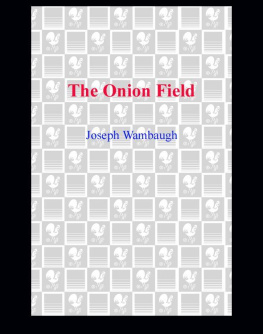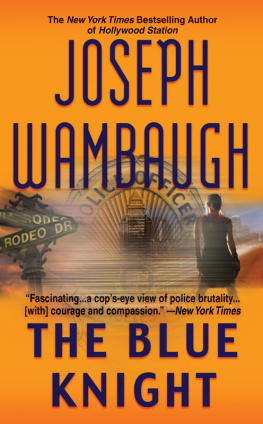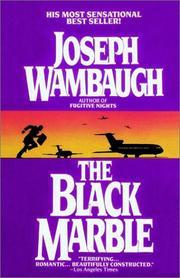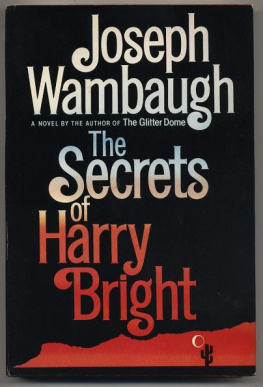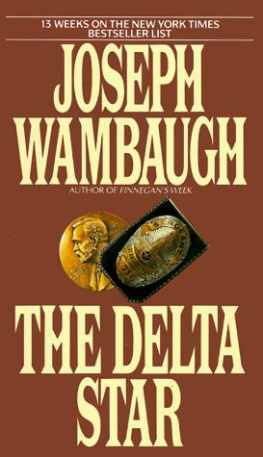Joseph Wambaugh - Blooding, The
Here you can read online Joseph Wambaugh - Blooding, The full text of the book (entire story) in english for free. Download pdf and epub, get meaning, cover and reviews about this ebook. year: 1995, publisher: Bantam, genre: Detective and thriller. Description of the work, (preface) as well as reviews are available. Best literature library LitArk.com created for fans of good reading and offers a wide selection of genres:
Romance novel
Science fiction
Adventure
Detective
Science
History
Home and family
Prose
Art
Politics
Computer
Non-fiction
Religion
Business
Children
Humor
Choose a favorite category and find really read worthwhile books. Enjoy immersion in the world of imagination, feel the emotions of the characters or learn something new for yourself, make an fascinating discovery.
- Book:Blooding, The
- Author:
- Publisher:Bantam
- Genre:
- Year:1995
- Rating:3 / 5
- Favourites:Add to favourites
- Your mark:
- 60
- 1
- 2
- 3
- 4
- 5
Blooding, The: summary, description and annotation
We offer to read an annotation, description, summary or preface (depends on what the author of the book "Blooding, The" wrote himself). If you haven't found the necessary information about the book — write in the comments, we will try to find it.
Blooding, The — read online for free the complete book (whole text) full work
Below is the text of the book, divided by pages. System saving the place of the last page read, allows you to conveniently read the book "Blooding, The" online for free, without having to search again every time where you left off. Put a bookmark, and you can go to the page where you finished reading at any time.
Font size:
Interval:
Bookmark:
The Blooding
Joseph Wambaugh
*
For The First Time, Joseph Wambaugh Turns His Attention Outside the United States to deal with two murders in neighboring English Midlands villages -- ancient villages that still have whitewashed Tudor cottages, pavements too narrow for passing baby prams, streets barely wide enough for two cars, and churches or pubs as the sites of community life. What intrigues the master of true-crime writing is that out of the sleepy setting grew a landmark case: the first murders solved by genetic fingerprinting.
The victims of the terrifying rape-murders --two fifteen-year-old girls who do not know each other--have in common one fatal mistake: they choose to walk village footpaths bordering the lands of a psychiatric hospital. Forever after, the names Ten Pound Lane and The Black Pad will evoke fear and dread.
The murders occur three years apart, and during all those years the members of the Leicestershire constabulary never give up their search. The local newspapers cooperate by keeping the cases alive. And the families of the victims try to cope with the chaos of their existence.
But the psychopath might never have been caught if a geneticist doing research on DNA at a nearby university had not stumbled upon a discovery: a procedure for mapping huma n g enes--a method of establishing a genetic fingerprint, unique to it's bearer, through a drop of blood.
The old and the new, the traditional and the startlingly up-to-date, combine for one of Joseph Wambaugh's most moving and most unusual books, the true story of a case that has revolutionized modern crime detection.
*
Author's Note:
This is the true story of the Narborough Murder Enquiry, the world's first murder case to be resolved by "genetic fingerprinting," a stunning scientific discovery that may well revolutionize forensic science as dramatically as fingerprinting did in the 19th century.
As always, I have re-created events only when my information comes from a reliable witness or can be independently corroborated.
Chapter
Three Villages
They say that in remote little English villages a newcomer can be accepted by the locals provided he buys property, pays his bills, and stays in continuous residence for about ninety-five years. The village of Narborough isn't remote, being only six miles southwest of the city of Leicester, and it's no longer so little--what with land developers enticing young families from urban housing estates with promises of safety and serenity--but it's a village nonetheless.
If you have an ear for pub chat, you might still hear an arcane village debate between elderly dart players as to whether or not Narborough existed during William the Conqueror's Domesday survey of 1086. A pre-Norman grave cover found in the garden of Narborough House dates from the 10th century, so it can be argued that Narborough was there, Domesday or not.
"If we ain't in the Domesday Book, we wasn't," is answered by "If we was in a Saxon graveyard, we was
But the young villager of today cares less about Domesday and more about the fact that Narborough is woefully short on entertainment; the church/pub ratio is two churches, two pubs. Well, three churches if you want to count the Catholics who showed up about forty years ago.
Narborough has a chemist's shop for pharmaceutical needs, a bakery and confectionary, a tobacconist, a mini-market and a National Westminster Bank. Also, there's a general store with an off-license, and there's "R. H. Howe, High Class Family Butcher," whose sign says: EST. 17m CENTURY. That's just down the road from the fruit and vegetable shop, which is next to the fishmonger's, which is across from the Narborough post office, whose lobby measures ten by fifteen feet.
And that's nearly all there is to the commercial center--that and the two public houses. They complain that the village is woefully short on pubs, but they've got two "boozers" in neighboring Littlethorpe, one of which serves very good Leicestershire pork pies.
The village of Littlethorpe is on the other side of the river Soar, ten minutes down Station Road (as measured by walking time), just past the tiny Narborough train station, erected in Victoria's day. Bordering Narborough on the north, a brisk twenty-minute walk up Ten Pound Lane, is the village of Enderby with a different sin-and-salvation mix: seven boozers, two churches. Enderby used to be a quarrying town and the working-class villagers look upon Narborough as being a bit upper crust, or "crusty." The recent growth of Narborough, Littlethorpe and Enderby causes fear that village identity will be lost entirely. Some think Enderby is already more of a township than a village.
But despite local debate among members of the parish council about the alarming influx of strangers, to an outsider the three communities still seem to be typical English Midlands villages. There are reassuring granite churches with mossy slate roofs, turrets and parapets glowing rosy and amber in the setting sun. The churchyards are cluttered with whimsical tottering headstones, parted by irregular stone footpaths worn shiny through the centuries. There are still enough whitewashed Tudor cottages with gnarled black beams and thatched roofs two feet thick, carrying the trademarks of master thatchers.
There is still the comfort of strolling on village pavements, too narrow for passing baby prams, along streets barely wide enough for two cars. Most villagers trouble to keep their doors and gutters painted: green, red, black, blue. And if all the door knockers and letter boxes are no longer brass, the shiny steel substitutes bespeak a certain pride that might not be found in many of the housing estates in the city.
Perhaps a village is still a village as long as local publicans need to post notices that say: PLEASE KEEP ANIMALS OFF SEATS. Smoky village pubs tolerate lazy terriers and setters, and even pit bulls, which obviously have better press agents than do their American cousins. Pub dogs must have the highest rate of lung cancer in the animal world, but their presenc e r emains as reassuring as empty milk bottles on the step of a whitewashed cottage.
Nobody gets specific as to how a Leicestershire country pub or village pub differs from those in the cities, but everyone agrees that they do. It's more than lower ceilings, adzed beams and ancient undulating floors. More than carpet, curtains and wallpaper, those touches that help define the uniquely British institution that acts as halfway house between taproom and home. Whatever it is, the village pubs are different. The Leicestershire pork pies taste better, and the Stilton cheese in a ploughman's lunch is, well, different. The village parish council provide parks and play areas, roadside seats, pavilions, nature boards and even a community center, but the village pubs, like the churches, provide a resting place.
The total population of all three villages is about twelve thousand souls, not counting the residents confined in Carlton Hayes Hospital. In 1938 the villagers thought it a good idea to change the name of the hospital, which was then called the Leicestershire and Rutland Lunatic Asylum. The hospital's farmland divides Narborough and Enderby and borders two footpaths: Ten Pound Lane on the east and The Black Pad on the west, names that came to evoke fear and dread.
The M l motorway cuts across the eastern tip of Narborough, near the Narborough Bogs, and turns directly north through Enderby, next to the playing fields of Brockington School where Mill Lane joins Ten Pound Lane. It was long debated whether or not a scream of terror from Ten Pound Lane could be heard across the six lanes of that motorway.
But there's no debate that it's in a village pub that an outsider can often come closest to monitoring the local pulse. It was in the village pubs that reporters would meet to seek gossip and tittle-tattle during the time of the Narborough Murder Enquiry. And it was in a pub that a casual comment would lead toward the solution of a case destined to become a landmark in the annals of crime detection.
Font size:
Interval:
Bookmark:
Similar books «Blooding, The»
Look at similar books to Blooding, The. We have selected literature similar in name and meaning in the hope of providing readers with more options to find new, interesting, not yet read works.
Discussion, reviews of the book Blooding, The and just readers' own opinions. Leave your comments, write what you think about the work, its meaning or the main characters. Specify what exactly you liked and what you didn't like, and why you think so.

